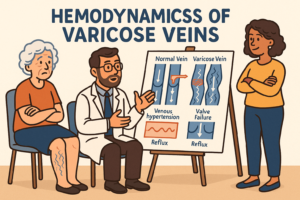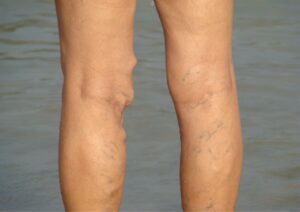Procedures like cesarean sections, assisted vaginal deliveries, and other obstetric surgeries significantly elevate the risk of venous thromboembolism (VTE) after pregnancy. Postpartum VTE risk is already 15-35 times higher than in non-pregnant women, and surgical interventions exacerbate this due to immobility, tissue damage, and blood loss. Key contributing factors include pre-existing conditions like thrombophilia, obesity, or previous VTE history. Additionally, prolonged labor or postpartum hemorrhage further elevate clotting risks.
Venous thromboembolism (VTE) is a rare but significant risk for women during pregnancy and especially in the postpartum period. While the overall incidence is estimated at 0.5 to 2 per 1,000 pregnancies, VTEs, including deep vein thrombosis (DVT) and pulmonary embolism (PE), are among the leading causes of maternal morbidity and mortality in developed countries. VTE risk increases 5-10 fold during the antenatal period, with a further increase to 15-35 fold postpartum (compared to age-matched non-pregnant women). Up to 50% of antenatal events occur in the first two trimesters. Clinical guidelines and studies emphasize the importance of antithrombotic therapy as a key prevention strategy to manage thromboembolic risks and minimize complications associated with VTE during pregnancy.
Understanding Venous Thromboembolism (VTE)
Venous thromboembolism (VTE) is a significant cause of maternal morbidity and mortality worldwide. This condition involves the formation of a blood clot in a vein, which can break loose and travel to the lungs, resulting in a pulmonary embolism (PE). VTE can occur at any time during pregnancy, but the risk is particularly high during the postpartum period. The physiological changes during pregnancy, such as increased blood volume and hormonal shifts, contribute to a hypercoagulable state, making pregnant women more susceptible to clot formation. Understanding the risks and symptoms of VTE is crucial for timely intervention and prevention.
What Increases Your Risk of VTE?
Several factors increase a woman’s likelihood of developing a VTE, including:
History of VTE: A personal or family history of VTE significantly raises the risk.
Known Thrombophilia: A blood clotting disorder can exacerbate the risk.
Obstetric Procedures: Cesarean sections, long or complicated labor, and postpartum complications such as hemorrhage or infections also increase the risk.
Lifestyle Factors: Being overweight, smoking, or immobility, particularly during long hospital stays, also contribute to the risk.
Other Medical Conditions: Comorbidities like preeclampsia, heart disease, high blood pressure, and inflammatory bowel disease further increase the chance of developing VTE.
Risk of Thromboembolism between Pregnant women vs Non Pregnant Women
Being pregnant and having a baby increases your chance of having a VTE by 4 to 5 times compared to women who are not pregnant, a condition known as pregnancy related venous thrombosis. This means 1 or 2 women out of every 1000 women having a baby will have a VTE. It can happen any time in your pregnancy, but the highest risk is in the first 6 weeks after you give birth. Your chance of having a VTE is higher if:
Before pregnancy you:
• have had a VTE before
• have a mother, father, brother or sister who has had a VTE
• have a medical condition (e.g. thrombophilia, heart disease, lung disease or arthritis)
• are over 35 years of age
• have already had three or more babies
• are overweight (BMI over 30)
• smoke cigarettes
• have bad varicose veins During pregnancy and/or
after birth you:
• have a caesarean section birth
• have a long or difficult labour and birth
• can’t move around as much (e.g. during long distance travel or if you are unwell in hospital)
• develop high blood pressure
• are having more than one baby (e.g. twins)
• lose a lot of blood or need a blood transfusion
• have your baby early (preterm)
Why Procedures Increase Clot Risk
Cesarean Sections (C-sections):
Cesarean sections (C-sections) are a well-documented risk factor for VTE. Women who undergo a C-section are at an increased risk of developing deep vein thrombosis (DVT) or pulmonary embolism (PE). This heightened risk is primarily due to the longer recovery time associated with C-sections, which can lead to prolonged immobilization and increased venous stasis. The surgical procedure itself can cause endothelial injury, further contributing to clot formation. Therefore, it is essential for healthcare providers to closely monitor women who have undergone C-sections for any signs of VTE and to implement preventive measures such as early mobilization and the use of compression stockings.
Obstetric Complications:
Obstetric complications, such as preeclampsia, placental abruption, and amniotic fluid embolism, can significantly increase the risk of VTE. These complications often lead to inflammation and damage to the blood vessels, creating a conducive environment for blood clot formation. For instance, preeclampsia is associated with endothelial dysfunction and a hypercoagulable state, both of which elevate the risk of venous thrombosis. Similarly, placental abruption can cause significant blood loss and vascular injury, further increasing the thrombotic risk. Recognizing and managing these complications promptly is vital to reduce the risk of VTE.
Prolonged Immobilization:
Prolonged immobilization is a significant risk factor for VTE, particularly during the postpartum period. Women who are bedridden or have limited mobility during pregnancy or after childbirth are at an increased risk of developing deep vein thrombosis (DVT) or pulmonary embolism (PE). This is because prolonged immobilization can lead to venous stasis, where blood flow in the veins slows down, making it easier for clots to form. Encouraging mobility, even in small amounts, and using mechanical prophylaxis like compression stockings can help mitigate this risk.
Procedures Known to have an increased risk of venous thromboembolism:
Certain medical procedures, such as central venous catheter placement and various surgical interventions, are associated with a significantly increased risk of venous thromboembolism (VTE). Women who undergo these procedures during pregnancy or the postpartum period should be closely monitored for signs and symptoms of VTE. The risk is particularly high due to factors like prolonged surgery time, tissue trauma, and postoperative immobility. It’s essential for pregnant women to be aware of these risk factors and to take proactive steps to prevent VTE. This includes staying mobile, avoiding prolonged immobilization, and maintaining a healthy lifestyle. If you have any concerns about VTE, it’s crucial to discuss them with your healthcare provider to ensure appropriate preventive measures are in place.
– Cesarean Sections (C-sections):
The most significant surgical risk, cesarean sections are associated with a higher likelihood of deep vein thrombosis (DVT) and pulmonary embolism (PE). Studies indicate that women undergoing a C-section have an approximately threefold increased risk of VTE compared to vaginal deliveries. This is primarily due to the surgery’s impact on blood vessels and reduced mobility post-surgery. Thrombotic events involving the inferior vena cava (IVC) can also occur after cesarean sections, leading to serious conditions like pulmonary embolism and necessitating medical interventions such as caval filters and anticoagulation therapy.
– Obstetric Complications:
Complex labor, including the use of forceps or vacuum extraction, can lead to endothelial injury, a key factor in clot formation. Hemorrhages and the need for blood transfusions further heighten this risk by inducing a hypercoagulable state as the body attempts to restore blood volume and healing. Additionally, obstetric complications like preeclampsia and placental abruption can increase the risk of pelvic vein thrombosis, a serious condition that requires prompt diagnosis and management.
– Prolonged Immobilization:
Post-surgical recovery often involves restricted movement, especially after cesarean sections. Extended periods of immobility, both before and after a procedure, reduce blood flow in the legs, making it easier for clots to form in the deep veins.
-Procedures Known to have an increased risk of venous thromboembolism:
Certain medical procedures are associated with a significantly increased risk of venous thromboembolism (VTE). These include major orthopedic surgeries like hip and knee replacements, which involve long recovery periods with reduced mobility, a key contributor to clot formation. Additionally, abdominal, pelvic, and cancer surgeries increase VTE risk because of prolonged surgery time, tissue trauma, and postoperative immobility. Spinal surgeries and other complex procedures with extended recovery periods can similarly raise the risk of VTE. Cerebral vein thrombosis (CVT) is a potential complication of these procedures, particularly due to the procoagulant state induced by surgery, which necessitates early diagnosis and management to prevent severe outcomes.
Risk Stratification
While risk factors for VTE are well recognised, due to the large number of clinical variables and the overall low frequency of VTE in the pregnant / postpartum population, there is a paucity of high-quality data specific to pregnancy on which to base recommendations. Published guidelines are based largely on observational studies, extrapolation from data in non-pregnant populations and consensus opinion. With the awareness of these limitations, each woman should be assessed individually, with a discussion regarding her risks of VTE and the treatment options.
What are the warning signs of deep vein thrombosis?
The clinical symptoms and warning signs of deep vein thrombosis (DVT) include:
Swelling: Particularly in one leg, typically in the calf or thigh.
Pain: Often starts in the leg and can feel like cramping or soreness.
Warmth: The affected area may feel warmer than the surrounding skin.
Discoloration: Skin over the area may turn red or have a bluish tinge.
Tenderness: Especially when standing or walking.
If you experience these symptoms, it’s important to seek medical attention promptly.
What Are The Complications of Deep venous Thrombosis Post Partum
Venous thromboembolism (VTE) can lead to serious and potentially life-threatening complications if not treated promptly. Deep venous thrombosis (DVT) affects the deep venous system and can lead to serious complications if not treated promptly. These complications include:
1. Pulmonary Embolism (PE):
Pulmonary Embolism (PE) is a serious and potentially life-threatening condition where a blood clot, often originating in the deep veins of the legs, travels to the lungs and blocks a pulmonary artery. This obstruction limits blood flow to the lungs, reducing oxygen levels in the blood and putting severe strain on the heart. Symptoms may include sudden shortness of breath, chest pain, rapid heart rate, and coughing up blood. If left untreated, PE can cause irreversible lung damage, heart failure, or death, necessitating prompt medical intervention.
2. Post-thrombotic syndrome:
Post-thrombotic syndrome (PTS) is a long-term complication of deep vein thrombosis (DVT), characterized by chronic pain, swelling, and skin changes in the affected limb. This condition occurs when the blood flow in the veins is impaired due to damage from the previous clot, leading to persistent inflammation and poor circulation. Symptoms can worsen over time, resulting in heaviness, discomfort, and sometimes skin ulcers. Managing PTS often involves compression therapy and lifestyle changes to improve circulation and reduce symptoms.
3. Chronic venous insufficiency:
Chronic venous insufficiency (CVI) is a condition where the veins in the legs have difficulty returning blood to the heart due to damaged valves or vein walls. This causes blood to pool in the lower limbs, leading to swelling, pain, and a feeling of heaviness. Over time, CVI can result in skin discoloration, thickening, and in severe cases, ulcers. It often develops following deep vein thrombosis (DVT) or prolonged varicose veins, and management includes compression therapy and lifestyle adjustments to improve circulation.
4. Recurrent VTE:
Recurrent VTE refers to the increased likelihood of developing another venous thromboembolism (VTE) after an initial episode. Once a person has experienced a VTE, their risk of recurrence remains elevated, particularly within the first few months following the event. This can occur due to underlying conditions like thrombophilia, chronic venous damage, or inadequate anticoagulation therapy. Recurring clots pose a serious health threat, including a higher risk of pulmonary embolism, and often require long-term management with blood thinners and lifestyle modifications to reduce future risk.
Clinical Approach to Prevention
Given these risks, healthcare professionals often initiate thromboprophylaxis, especially in high-risk individuals. The use of Low Molecular Weight Heparin (LMWH) is widely recommended in guidelines to prevent clot formation. This anticoagulant is safe during pregnancy and postpartum, even for women undergoing major procedures.
Additionally, mechanical prophylaxis such as compression stockings or intermittent pneumatic compression devices is employed to promote blood flow in the legs during hospitalization. For certain patients, a combination of pharmacological and mechanical methods may be necessary to mitigate the high-risk clotting factors associated with surgery.
Prevention and Treatment
Early assessment of VTE risk during pregnancy and after childbirth is essential. Preventative measures include maintaining a healthy weight, quitting smoking, and staying active. For high-risk individuals, doctors may recommend interventions like:
Low Molecular Weight Heparin (LMWH): This anticoagulant is commonly used for thromboprophylaxis in pregnancy due to its safety.
Compression Stockings: These help improve circulation and reduce clotting risk.
Intermittent Pneumatic Compression (IPC): Inflatable cuffs around the legs used in hospitals to stimulate blood flow during immobility.
Hydration and Movement: Staying hydrated and mobile can lower VTE risk during long hospital stays or after cesarean sections.
While the risk of VTE is relatively low, the consequences can be severe, particularly with pulmonary embolisms, which have a 25% incidence rate and are fatal in about 1 in 40 cases. Thus, vigilant assessment and, when necessary, prophylactic treatment are essential for minimizing VTE risks in new mothers.
Risk Assessment and Personalized Care
Given the numerous individual factors that influence clot risk—such as age, weight, and medical history—tailoring thromboprophylaxis to each patient is critical. Risk assessment tools and flowcharts are used in hospitals to categorise patients into low, moderate, and high-risk groups, determining the need for anticoagulant therapy. For high-risk women, the prophylaxis may begin during pregnancy and extend for several weeks after birth.
Conclusion
While VTE is a rare complication, the risks associated with surgical procedures during or after pregnancy demand vigilance. Risk for postpartum venous thromboembolism is highest during the first 3 weeks after delivery. Women with obstetric complications are at highest risk for postpartum venous thromboembolism, and this risk remains elevated throughout the first 12 weeks after delivery. Personalised care, early risk assessment, and prompt use of thromboprophylaxis are crucial in preventing fatal outcomes, such as pulmonary embolism, particularly for women undergoing cesarean sections or other obstetric surgeries.









